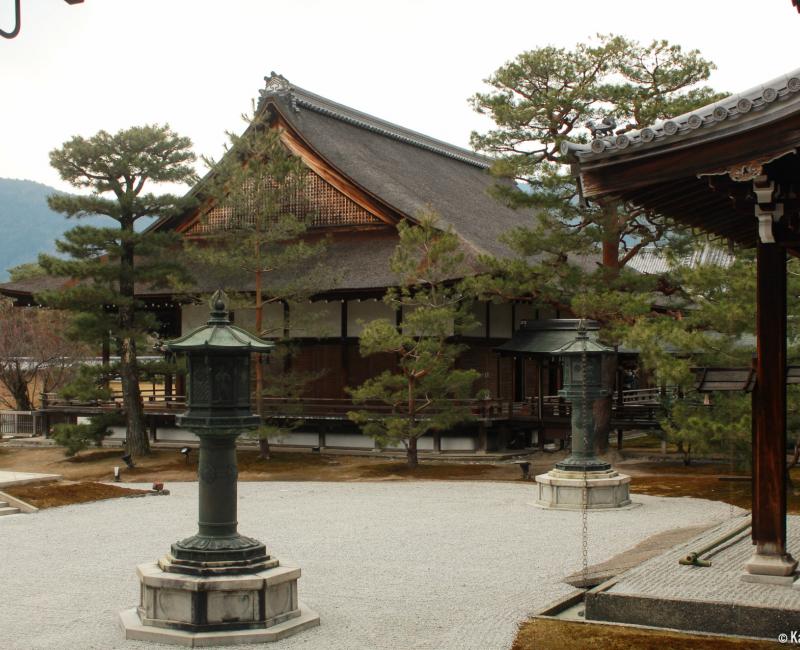Daikaku-ji
The Imperial Complex in Sagano
Daikaku-ji is a temple complex of the Shingon Buddhist school, located in the north of Sagano ward in Kyoto. Formerly an imperial residence since the Japanese antiquity, its various pavilions and its large Japanese garden will delight amateurs of religious history and flower arrangement.
Daikaku-ji’s area was first a villa built for Emperor Saga in the early 800s, and later became his residence after his retirement, and such use continued with several retired emperors afterwards. The temple itself was however founded in 876 by Saga’s daughter Masako, and became a Monzeki: a temple whose abbot is always a member of the imperial family. The temple is affiliated to one of the oldest Buddhist currents in Japan, the Shingon school.
At the end of the 14th century, peace between the Northern and Southern Courts was achieved here, ending about fifty years of civil war. Daikaku-ji temple is also featured in Murasaki Shibibu’s Tale of the Genji.

Historical and religious treasures
The complex gathers several buildings of various periods, and from various places. Several were designated Important Cultural Property, but many are not open to the visit.
Outdoor wooden corridors, such as Murasame no Roka, connect the buildings. Like in Nijo Castle 🏯, their floor includes a particular system, the "nightingale floor" that is very popular among tourists. Thanks to a hidden device, it produces a chirping sound each time someone sets a foot on it.
Indoor, especially in the Shinden, one of the main building relocated here during the Edo period (1603 – 1868), the sliding doors display Momoyama period (end of 16th century) paintings by several artists of the Kano School.
One of Daikaku-ji’s most important treasures is the handwritten copy of the "Heart Sutra" (Hannya Shingyo 般若心経) carefully preserved here. According to the legend, the copy was made by Emperor Saga himself on the request of monk Kobo Daishi to put an end to a severe epidemic during the Heian period. This treasure is concealed in the heart of the Sutra Hall and is viewable once every sixty years, the last time being in 2018. Nearby stands the Reihokan, a small museum that unveils various treasures of the temple in spring 🌸 and in autumn.
Its large dry garden is surrounded by the Shinden pavilion, the Miedo pavilion which is used as an intermediary between worshipers and the Heart Sutra, and the main hall Godai-do, dedicated to the 5 Wisdom Kings and especially Fudo Myoo. In October 2017, it was keeping up with its time by displaying a giant 800m² gravel drawing to celebrate the twentieth anniversary of the manga One Piece:
The last Japanese garden of the Heian period
Visitors are then invited to walk around Osawa Pond, that is even older than the complex itself. Of a 2,4 hectares superficies, it was created by emperor Saga himself. The pond is therefore the oldest aquatic garden and the last example of chisen shuyu style gardens, that were designed for boating.
The body of water was first intended for the emperor’s pleasures: a place where he could fish and overall, a privileged place for moon viewing on a barque. Two islands, a large and a small, the later known as the "Chrysanthemum Island," were constructed at the north end of the pond. The scenery was completed by several Buddhist statues, a small shrine, and the two-stories Shingyo Hoto pagoda, built in 1967 to commemorate the 1150th anniversary of the Heart Sutra.
We recommend visiting in spring during the cherry blossom season or in autumn to admire the beautiful red of the maple trees’ leaves on the Momiji 🍁 Road. At the same season, during three evenings whose dates are set according to the harvest moon, a historical re-enactment called Kangetsu no Yube brings back the aquatic festivities of the nobility to observe the Moon.
It is also said that emperor Saga initiated ikebana, the art of flower arrangement, and therefore Daikaku-ji temple would be at the origins of this art 1,200 years ago. Nowadays, the temple is also home to the headquarters of the Saga Goryu ikebana school since 1937.

